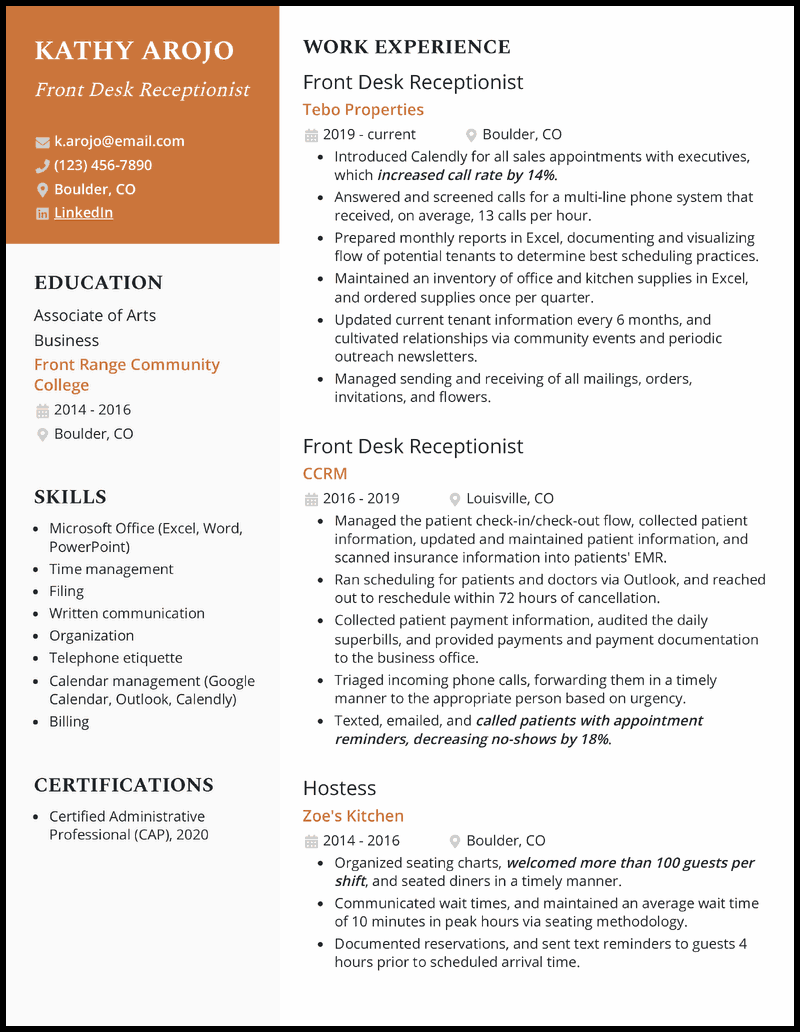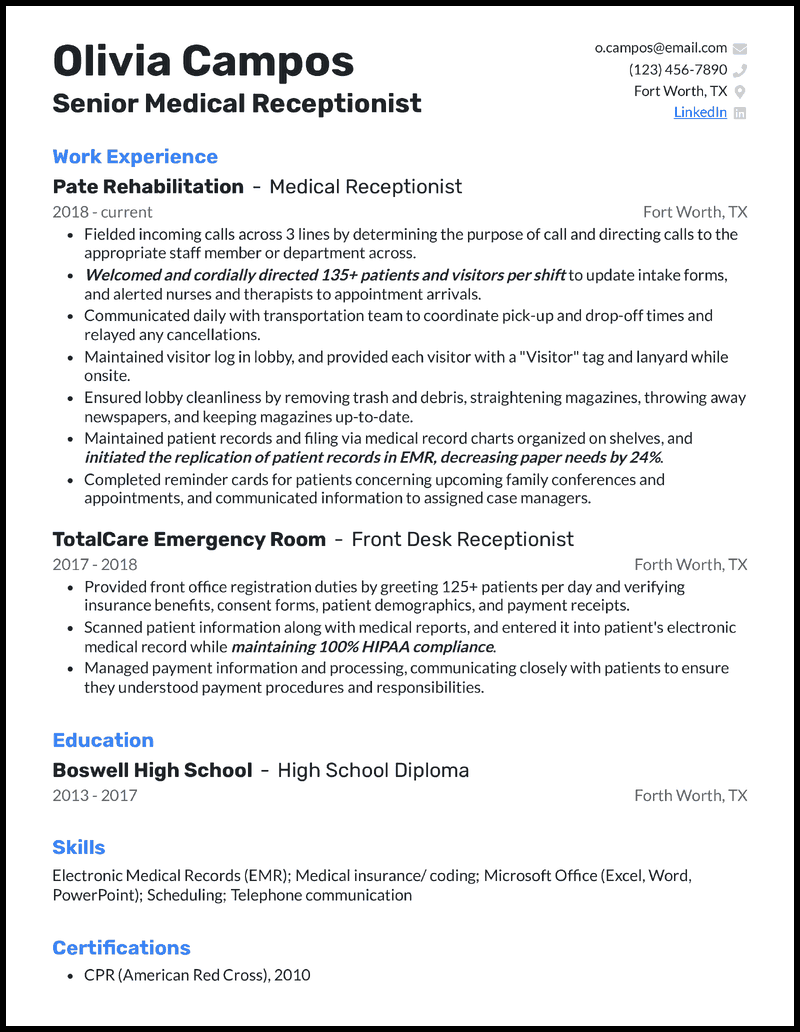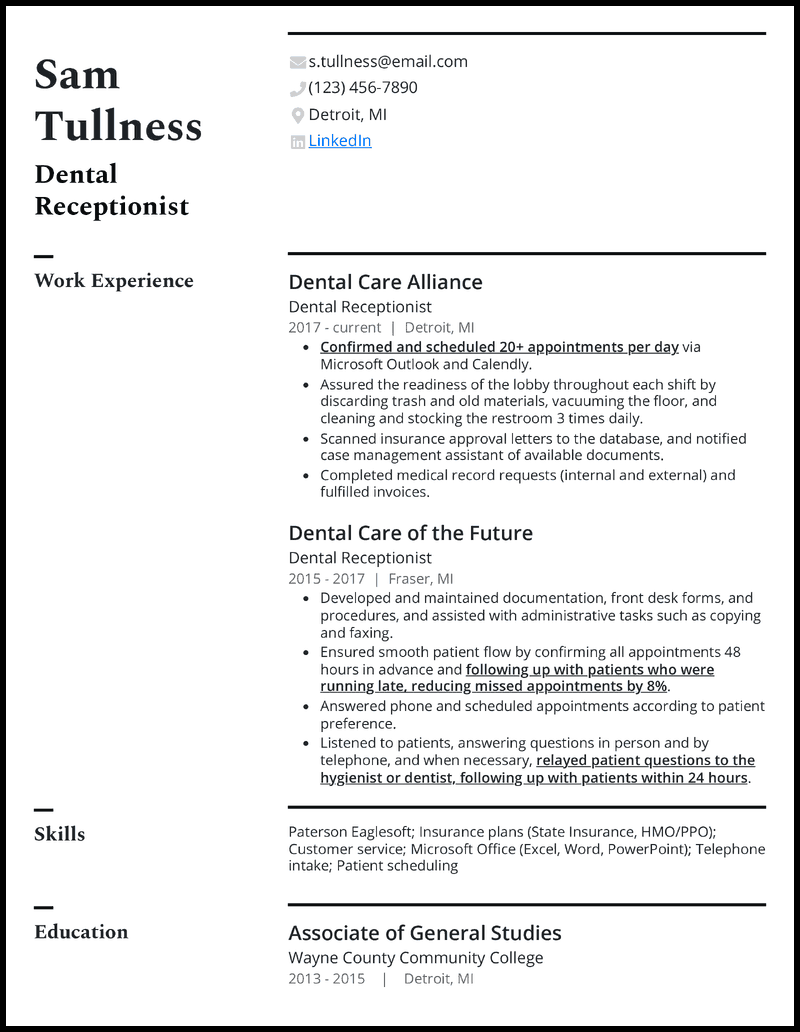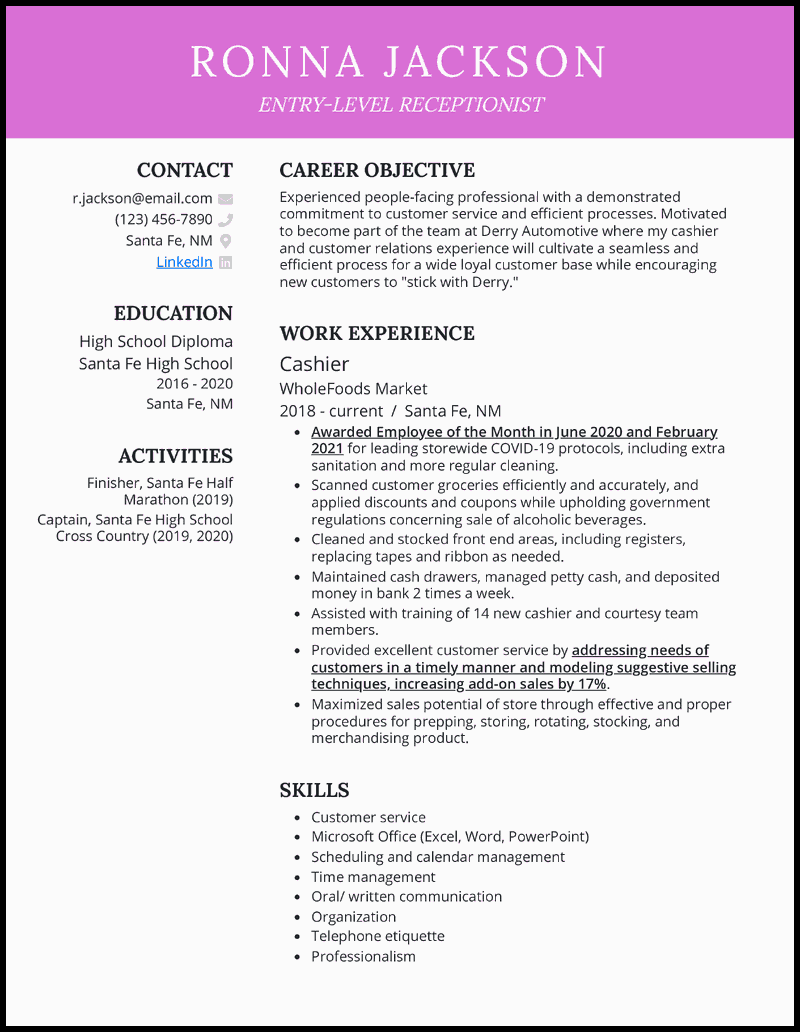A well-crafted receptionist resume will demonstrate your passion for assisting customers and clients, as well as fostering a welcoming ambiance. According to the U.S. Bureau of Labor Statistics, this role is unlikely to decline until 2034, indicating its stability.
Naturally, it’s a job sought after by many people, but writing a resume or creating a cover letter for it needs careful editing. That’s why we’ve put together this guide. We’ll take you through:
- ↪ 9 strong receptionist resume examples
- ↪ Resume tips to bring out your prowess in assisting customers
- ↪ The best formatting strategy to beat any ATS system
Why this resume works
- A resume objective is by no means required on your receptionist resume. In fact, you’re likely better off not including one. There are a few exceptions to this rule, like when you’re undergoing a career change or want to take the time to customize it to each job for which you apply.
Why this resume works
- Receptionists sometimes have trouble demonstrating the impact of their work on their front desk receptionist resume. When possible, you can do this by quantifying the value of your work (estimates are perfectly fine). For example, perhaps you could tie the creation of reports in Excel to the number of manual hours saved.
View more front desk receptionist resumes >
Why this resume works
- Most receptionist jobs in the medical field require that you’re certified in either CPR or Basic Life Support (BLS). CPR is more common and quicker to obtain while BLS is more comprehensive. Also, don’t hesitate to list any medical-specific skills you have, like electronic medical records (EMR) and insurance claims/coding.
View more medical receptionist resumes >
Why this resume works
- Any domain-specific experience that you have provides a great opportunity to customize your resume for each job description. Simply mention those skills (such s “Paterson Eaglesoft”) in the resume skills section of your dental receptionist resume.
View more dental receptionist resumes >
Why this resume works
- Do you notice how this veterinary receptionist resume combines competencies in different areas and supports them with measurable achievements? In particular, show how your streamlined check-in and check-out processes and your input in improving post-outcomes.
Why this resume works
- Capitalize your ability to handle guest complaints and upsell room upgrades and services with quantifiable work experience for your hotel receptionist resume! Last but not least, mention your educational qualifications in hospitality management or a relevant field and you’re good to go.
Why this resume works
- Salons can get busy at peak times, and impatient customers may not be willing to wait. Ensuring shorter wait times would be a great highlight in your salon receptionist resume. Additionally, show how you collaborated with the rest of the team to deliver exceptional services, leading to higher satisfaction ratings and turning first-time customers into loyalists.
Why this resume works
- It’s perfectly okay to talk a bit about your relevant hobbies and interests (called “Activities” in this resume) in your entry-level receptionist resume. Focus on activities that demonstrate leadership or serious dedication.
Related resume guides
How to format a Receptionist Resume

The key to creating an exceptional receptionist resume is choosing the perfect format. While the format might seem like an arbitrary decision, it’s what will ensure your resume is readable, logical, and complete. A resume with no format at all is likely to be disorganized, and a resume with the wrong format won’t highlight the right information. Your resume’s structural foundation should allow all the other aspects to fall neatly into place.
You can format your resume by taking a few simple steps:
- Choosing between reverse-chronological, functional, and hybrid formats
- Listing your contact information to create a header
- Taking ATS and readability into account

Reverse-chronological, functional, and combination/hybrid formats
Before you can start writing your resume, you need to decide which particular format you’ll use. The three most popular resume formats in 2026 are reverse-chronological, functional, and combination/hybrid. Each of these styles has its benefits and disadvantages, and plenty of job candidates have found success using all of them.
Which resume format should you choose for your receptionist resume?
- The reverse-chronological format is the most common option across industries. With this format, relevant work history is listed and explained in reverse-chronological order. This means your most recent position will be listed first. The main advantage of the reverse-chronological format is that it highlights your most recent, and likely most relevant, achievements, which should represent the high point of an upward career trajectory.
- The functional format is meant to highlight and showcase the candidate’s skills. Work experience is pushed to the bottom of the document, while abilities and areas of expertise take center stage. While this can be a good option for younger candidates with little experience, many job recruiters are especially interested in work history, the very category that this format marginalizes.
- Combination/hybrid resumes seek to make the most of both the reverse-chronological and functional formats. A hybrid resume will usually include work history listed in reverse-chronological order alongside a prominent skills component.
For your receptionist resume, it’s usually best to go with the reverse-chronological format. Recruiters and hiring managers are primarily interested in your work experience, so it makes sense to make it easy to find what they’re looking for.

How to craft a perfect contact and header section
At the top of your resume, you need to lay out your name and contact information. This brief header will act as a business card, letting people know immediately who you are and how they can contact you. Stating this information clearly at the top of the page, as seen in our numerous resume samples, will make it easier for recruiters to spot and file your resume.
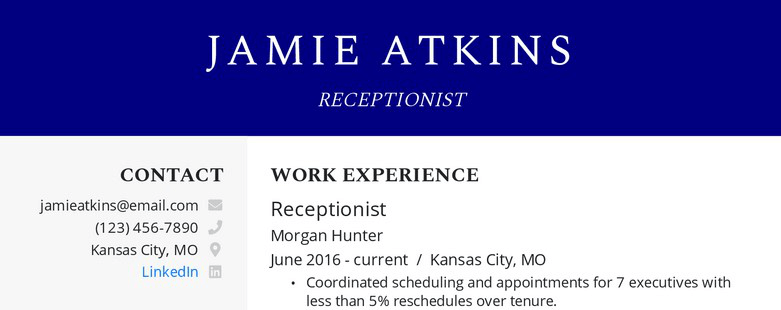
in 2026, the header for a receptionist resume should include:
- Your name
- The job title you’re seeking
- A phone number
- Your email
- City and state
- A professional social site, like LinkedIn, if you have one
To make it as easy as possible for recruiters to contact you, it’s important to make your header stand out. You can do this by increasing the font size for your name, using a splash of color, and/or bolding labels like “phone” and “email.”

How to pass ATS and ensure your receptionist resume is readable
We live in an increasingly technological world, something you’ll have to keep in mind when creating your receptionist resume. These days, many companies screen applicants using an applicant tracking system (ATS). This technology rapidly checks resumes for certain keywords before determining which candidates deserve a look from recruiters. For your resume to make the cut, you’ll need to consider how ATS works and what it looks for.
You can maximize your resume’s chances of finding favor with ATS by adopting a few key strategies. First of all, use an ATS-friendly file type like .pdf or .docx. Also, sprinkle some central keywords throughout the document, especially phrases that correspond to the soft and hard skills you’ve gained as a receptionist. Finally, make sure you avoid putting these keywords in the header where ATS might not find them.
It’s also important to make your resume as readable as possible. Maximize readability by taking a few basic steps:
- Include 1-inch margins (ideally) on every side of the document.
- Use a simple font like Times New Roman or Arial.
- Use 11-12-point font for general text and 14-16-point font for headers.
- Keep the titles of sections short and specific.
- Keep the entire resume on a single page.
- List your skills in a succinct, concise fashion.
Our convenient and easy resume builder takes all this into account, ensuring that your resume will be easy for recruiters to read.
How to Write a Receptionist Resume

If writing your receptionist resume seems a daunting task, you’re far from alone. Lots of people worry they’ll make costly mistakes and ruin their chances of landing the job. At this stage, it’s important to take a deep breath and acknowledge that you have what it takes to write a fantastic resume. All you need to do is take it step by step and use our resume builder. This methodical approach will take the stress out of the process while helping youcreate a resume that makes you stand out as a candidate.
Here’s what you’ll have to consider:
- Objective/Summary
- Work experience
- Receptionist skills
- Education and certifications
- Projects, interests, and/or hobbies
- Tailoring your resume to the job
- Editing and proofreading

Do you need an objective or summary on your receptionist resume?
Some candidates place a brief description at the top of their resumes to draw immediate attention to their strongest qualities. These descriptions can take the form of an objective or a summary. A resume objective spells out the candidate’s career goals while a resume summary succinctly states a candidate’s qualifications. As you apply for receptionist positions, you’ll have to decide whether either of these options is right for your resume.
- A resume objective is ideal for candidates who are seeking to make a career change. Pronouncing your goals in a new field and explaining how your current skills will translate to your career as a receptionist will present you as a stronger applicant.
- A resume summary is great for someone with years of experience as a receptionist. The summary gives you a chance to highlight all you’ve accomplished.
- Including neither an objective nor a summary might be the right call for certain applicants. If you think your experience speaks for itself or if you simply don’t have room on the page, there’s nothing wrong with skipping this step altogether. Ultimately, you get to determine the best way to showcase your talent and experience.
If you decide to include a summary or objective, you must make them clear and succinct. Here are two examples that would do a prospective candidate more harm than good:
- Objective: I’m really excited to start work as a receptionist, something I’ve been thinking about for years. Getting a job as a receptionist would truly be a dream come true.
- Summary: I’m a great receptionist who has worked for several major companies. During my time in the profession, I’ve learned all the strategies and techniques necessary to excel.
These examples are boring and vague. They tell recruiters nothing about the candidate’s specific capabilities, and they take up valuable space while accomplishing nothing.
These examples, on the other hand, effectively convey talent, experience, and strength of purpose:
Why this resume works
- Objective: Tech-savvy and organized professional seeking a receptionist position where typing and interpersonal skills will prove beneficial. Motivated to leverage retail experience and customer care to enhance office dynamics, efficiency, and environment.
- Summary: Seasoned receptionist currently serving at the front desk of a large car dealership with years of experience inputting complicated data. My empathy coupled with quick thinking and resourcefulness has contributed to company reputation and lifelong customer satisfaction.
These successful examples include traits, skills, and goals. They’re also specific and concise, providing recruiters with as much information as possible in a small amount of space.

How to present your receptionist job experience
First and foremost, recruiters are going to be interested in your work history. Try to include 2-4 jobs relevant to the position you’re currently applying for; however, if you lack receptionist experience, you can include positions that may seem irrelevant. As you write your work experience, consider how you may have used receptionist skills in previous positions, and draft your bullet points with those duties and accomplishments in mind. If you’ve held many relevant positions throughout your career, then use your judgment to determine which jobs will most help your chances.

How to write receptionist job experience bullet points
Beneath each job title in the work experience section, you should include 3-6 bullet points that briefly explain your obligations and accomplishments. You can employ some stylistic tricks to get the most out of these descriptions.
Start the bullet points with forceful action verbs in the past tense. This type of language demonstrates your tangible role with the company or organization. You can also leave out the personal pronoun “I.” The reader already knows you’re the subject of every sentence, and full sentences with a subject and a predicate take up too much space. If your bullet points are phrases rather than full sentences, make sure you don’t put a period at the end.
Don’t succumb to these sorts of bullet points:
- I was in charge of all sorts of important tasks.
- Almost every single day, I had to deal with some unforeseen circumstance.
- The offices saw tons of traffic on a daily basis, and I had to document all the visitors and make sure they had legitimate reasons for being on the premises.
These examples are vague and sloppy. They use too much space to say very little, and they don’t focus entirely on the candidate’s actions and obligations.
Here are some better examples:
- Oversaw scheduling and communication of many facets of the company’s operations, including customer service, accounting, and partner relationships.
- Determined how best to deal with disruptive and unexpected visitors, successfully de-escalating 100% of situations through step-by-step company methods.
- Documented visitor activity and monitored visitor logs for security threats, reporting unusual activity to security within 20 seconds.
The language in these bullet points is succinct and powerful, letting recruiters know your exact impact.

How to quantify your value as a receptionist
You should supplement the effective use of language with meaningful statistics. Quantifiable data will show recruiters that you’re not all talk. Any number that demonstrates the impact you had in your previous positions will go a long way toward convincing recruiters that you have what it takes to be a difference-maker.
While you don’t want numbers to overtake your entire resume, about 60% of your bullet points should employ the use of metrics.
Keep the following in mind to quantify your receptionist impact:
- Include any metrics showing your contribution to a company’s growth or efficiency.
- Describe how you saved quantifiable assets like time or money for the organization.
- Quantify everything you can. Scan your resume for words like “many” and “several,” then try to replace them with numbers.
- If you can’t remember an exact number, feel free to use a range.
- Always place statistics within the context of your specific contributions.


What metrics matter most for receptionists?
When it comes to metrics, receptionists must mention KPIs that show how a hotel/office benefited from customer experience. Some of these include:
- Time to resolve inquiries
- Customer satisfaction score
- Booking accuracy
These impacts can directly tie into a company’s profits and show you moved the needle on things that matter.

Should Receptionists Include HIPAA Training or Privacy Protocols?
Yes. Having HIPAA/OSHA training or privacy protocols takes your credibility up a notch. There are various ways of showing these programs, such as:
- Certificates
- Listing them as skills
- Mentioning them in work experience

Should entry-level candidates include volunteer or school experience?
Absolutely! Entry-level candidates must use their school projects and any volunteer stints to their advantage. These give insight into your early participation and related experience.
Don’t have either? Don’t stress about it. Even the options below can work:
- School office assistant roles
- Student organization leadership
- Part-time roles
Overall, just include any time when you had to use communication, customer service, and organizational skills simultaneously.

What are the best receptionist skills to Include on your resume?
The skills section of a resume gives you the chance to sell yourself to recruiters. It’s important to mention both hard skills and soft skills in the document. Hard skills are technical and measurable, and, for a receptionist, they include things like:
- Foreign languages
- Database management experience
- Technological know-how or typing speed
Soft skills, on the other hand, are not quite as easy to measure and encapsulate habits, traits, and disciplines. Examples include:
- Attention to detail
- Communication skills
- Open-mindedness
When listing your skills, use some of the same keywords you see in the job description for the position. This will draw the attention of ATS systems and human readers. Try to list 5-10 skills, depending on the amount of space you have available.

How to include education and certifications on your receptionist resume
While most receptionist jobs require only a high school diploma, it still makes sense to include all the education credentials you’ve acquired. This includes associate’s degrees, bachelor’s degrees, and any additional higher education. You should also include any certifications you’ve received as a receptionist, especially those pertaining to a specific subcategory of the profession. These details could set you apart from other applicants.

Does your receptionist resume need projects, interests, or hobbies?
There’s some debate about whether projects, hobbies, and interests belong on a resume. In general, it’s better to skip these types of personal details in favor of adding more skills and work experience. There are particular cases, however, where this background information could work in your favor. For anyone fresh out of school or new to the workforce, projects and interests can help get a foot in the door.
Some candidates simply lack the relevant work experience they’d like to put on their resume. If you find yourself in that position, projects and hobbies give you another way to show recruiters why you would make a great receptionist.
When listing projects and hobbies, make sure you choose details related to the job you’re seeking. Pick interests requiring skills that would translate well to a receptionist position. Projects worth listing include organizing a food drive and creating a new club in school. These types of endeavors require the same skills and habits that recruiters will be looking for in a receptionist.
Hobbies and interests like researching your ancestry and planning parties are also smart to include. By showing recruiters that you’re employing the skills you’ll need on the job, you can make up for a lack of experience.

How to customize your receptionist resume for the position
Every receptionist job you apply to will have its own set of responsibilities and expectations. To give yourself the best chance of success, you should create a separate version of your resume for each application. This doesn’t mean you have to start the document from scratch. Simply look for skills or certifications that are stressed in a particular job advertisement and make corresponding adjustments to your original document.

Edit and proofread your receptionist resume
This might be the most obvious step in the entire process, but it’s one that far too many people overlook. A few typos or spelling errors might not seem like a big deal, but recruiters will take it as a sure sign of carelessness. When competition for a position is fierce, you can’t afford to put yourself in a hole. Re-read the document several times before sending it, and take advantage of our quick and easy resume checker to spot pesky issues concerning consistency, active voice, resume length, and more.
Land Your Receptionist Job

There’s a basic roadmap all job seekers should follow in creating the perfect receptionist resume. It looks something like this:
- Choose the format that works for your career path
- Create a header with contact information
- Decide if you need a resume objective or a resume summary
- Write out your work experience with strong, active language
- Include your hard and soft skills
- Create customized versions of your resume for every job
- Revise and proofread
Once you’ve followed the steps above and completed your resume, give yourself a hearty pat on the back before knocking out your receptionist cover letter. All this hard work should pay off in the form of greater attention from recruiters. Before you know it, you will have landed your next job!
Receptionist Resume FAQs

A receptionist’s resume that stands out must be concise and appealing for recruiters to read it to the end. You must showcase your competencies in handling front-office affairs by discussing numbers defining your accomplishments. Also, you must include your prowess in tools, software, and soft skills. Let recruiters read your piece and immediately know this is the kind of candidate they want.
A strong receptionist resume should have the following elements:
✅ Versatile skillset
✅ Tailored work experience
✅ Certifications in specialized training
✅ A well-spaced template
A healthy blend of all these components will help you craft a standout receptionist resume and improve your chances of getting hired.
Look at the job posting and pick keywords that the potential employer seems to care about. It could be skills or industry-specific jargon; you need that to align with the hiring manager’s expectations. When you write your work experience bullet points, use those crucial phrases. Don’t forget to quantify your accomplishments because it’s one way of staying ahead of the competition.
As a receptionist, you must have role-specific skills, which help you get things done in a way that recruiters can’t say no to your resume. Key competencies you need include schedule management, customer service, problem-solving, computer knowledge, and excellent communication. If you can showcase your use of these abilities from your previous related roles, then the job will be yours.
Typically, the best resume format for a receptionist resume is the reverse-chronological order. Using this format helps you list your latest achievements at the top and makes it easier for employers to understand your strengths.




![9 Receptionist Resume Examples [& Templates]](https://beamjobs.wpenginepowered.com/wp-content/uploads/2024/02/receptionist-resume.png)

